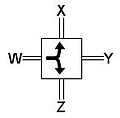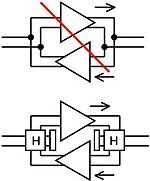Hybrid coil

A signal arriving on one branch is divided between the two adjacent branches but does not appear at the opposite branch. In the schematic diagram, the signal into W splits between X and Z, and no signal passes to Y. Similarly, signals into X split to W and Y with none to Z, etc.
Correct operation requires matched characteristic impedance at all four ports.
Explanation

Hybrid coil circuit diagrams
Hybrids are realized using transformers. Two versions of transformer hybrids were used, the single transformer version providing unbalanced outputs with one end grounded, and the double transformer version providing balanced ports.
Single transformer hybrid

Double transformer hybrid
When both the 2-wire and the 4-wire circuits must be balanced, double transformer hybrids are used, as shown at right. Signal into port W splits between X and Z, but due to reversed connection to the windings, cancel at port Y. Signal into port X goes to W and Y. But due to reversed connection to ports W and Y, Z gets no signal. Thus the pairs, W & Y, X & Z, are conjugates.
Applications
Hybrids are used in telephones (see telephone hybrid) to reduce the sidetone, or volume of microphone output that was fed back to the earpiece. Without this, the phone user's own voice would be louder in the earpiece than the other party's. Such hybrids also had their windings so arranged as to act as an impedance matching transformer, matching the low-impedance carbon button transmitter to the higher impedance parts of the system. Today, the transformer version of the hybrid has been replaced by resistor networks and compact IC versions, which uses integrated circuit electronics to do the job of the hybrid coil.
Radio-frequency hybrids are used to split radio signals, including television. The splitter divides the antenna signal to feed multiple receivers.
See also
External links
- Douglas Rice (2008) Modelling Telephony Hybrids as 2 × 2 Matrices
References
![]() This article incorporates public domain material from the General Services Administration document "Federal Standard 1037C" (in support of MIL-STD-188).
This article incorporates public domain material from the General Services Administration document "Federal Standard 1037C" (in support of MIL-STD-188).